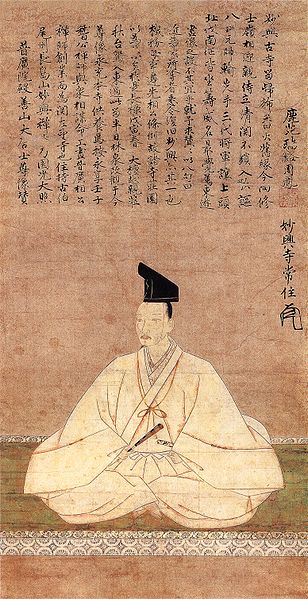<Back to Index>
- Physician William Osler, 1849
- Writer and Artist Bruno Schulz, 1892
- 6th Shogun of the Ashikaga Shogunate Ashikaga Yoshinori, 1394
PAGE SPONSOR

Ashikaga Yoshinori (足利 義教, July 12, 1394 – July 12, 1441) was the 6th shogun (rokudai shogun) of the Ashikaga shogunate who reigned from 1429 to 1441 during the Muromachi period of Japan. Yoshinori was the son of the third shogun Ashikaga Yoshimitsu.
After the death of the fifth shogun Ashikaga Yoshikazu in 1425, the fourth shogun Ashikaga Yoshimochi resumed his role as head of the shogunate. Yoshimochi had no other sons, nor did he name a successor before he himself died in 1428.
Yoshinori, who had been a Buddhist monk since the age of ten, became Seii Taishogun on the day of Yoshimochi's death. From amongst the handful of possible Ashikaga candidates, his name was selected by the shogunal deputy (Kanrei), Hatakeyama Mitsuie, who drew lots in the sanctuary of Iwashimizu Hachiman Shrine in Kyoto; and it was believed that Hachiman's influence had affected this auspicious choice.
Significant events which shaped the period during which Yoshinori was shogun:
- 1429 – Yoshinori appointed shogun.
- 1430 – The Southern Court's army surrenders.
- 1432 – Akamatsu Mitsusuke flees; Yoshinori receives rescript from China.
- 1433 – Ōtomo rebells; Hieizan monks rebel.
- 1434 – Tosen bugyō established to regulate foreign affairs.
- 1436 – Yasaka Pagoda at Hokanji in Kyoto destroyed by fire.
- 1438 – Kantō kubō Ashikaga Mochiuji rebels – Eikyō Rebellion.
- 1439 – Mochiuji commits suicide; dissatisfaction with Yoshinori grows.
- 1440 – Yasaka Pagoda at Hokanji in Kyoto re-constructed by Yoshinori.
- 1441 – Yoshinori grants Shimazu suzerainty over the Ryūkyū Islands; Akamatsu murders Yoshinori – Kakitsu Incident; Yamana kills Akamatsu.
Yoshinori strengthened the power of the shogunate by defeating Ashikaga Mochiuji in the Eikyo Rebellion of 1438. During the period, Chinese contacts were increased and Zen Buddhism gained influence, which had broad cultural consequences. For example, the Hon-dō or main hall at Ikkyu-ji is today the oldest standing T'ang style temple in the Yamashiro (southern Kyoto Prefecture) and Yamato (Nara Prefecture) Provinces. It was built in 1434 and was dedicated by Yoshinori.
In 1432, trade and diplomatic relations between Japan and China were restored. Both had been discontinued by Yoshimochi. The Chinese emperor reached out to Japan by sending a letter to the shogunate via the kingdom of the Ryūkyū Islands; Yoshinori responded favorably.
According to Mansai Jugo Nikki (満済准后日記), the system of the Tosen - bugyō (唐船奉行) was established in 1434 to mediate oversee trade. The functions of the Tosen - bugyō included: (1) defending trading ships in Japanese waters, (2) procuring export goods, (3) mediating between the Muromachi shogunate and shipping interests, and (4) managing record keeping. It is significant that the Muromachi shogunate was the first to appoint the executive officers of the samurai class to high positions in its diplomatic bureaucracy. After Yoshinori's time, the totosen (渡 唐船) (the fleet of ships going from Japan to Ming China) consisted of the ships belonging principally to three different kinds of owners: the Muromachi shogun, temples, and the shugo daimyo.
Yoshinori was notorious for his oppressive measures and unpredictable dictatorial whims. Yoshinori was assassinated at the age of 48 by Akamatsu Mitsusuke, who had learned that Yoshinori planned to bestow on a youthful male favorite three provinces belonging to Mitususuke; shortly thereafter, it was determined that his 8 year old son, Yoshikatsu, would become the new shogun.
Although the Ashikaga line continued through this seventh shogun, the power of the shoguns gradually eroded and the shogunate fell into decline. The mere fact of that assassination and treason had become a reality had served to undercut the previous military ethic of loyalty.
The years in which Yoshinori was shogun are more specifically identified by more than one era name or nengō. Eikyō (1429 – 1441); Kakitsu (1441 – 1444).